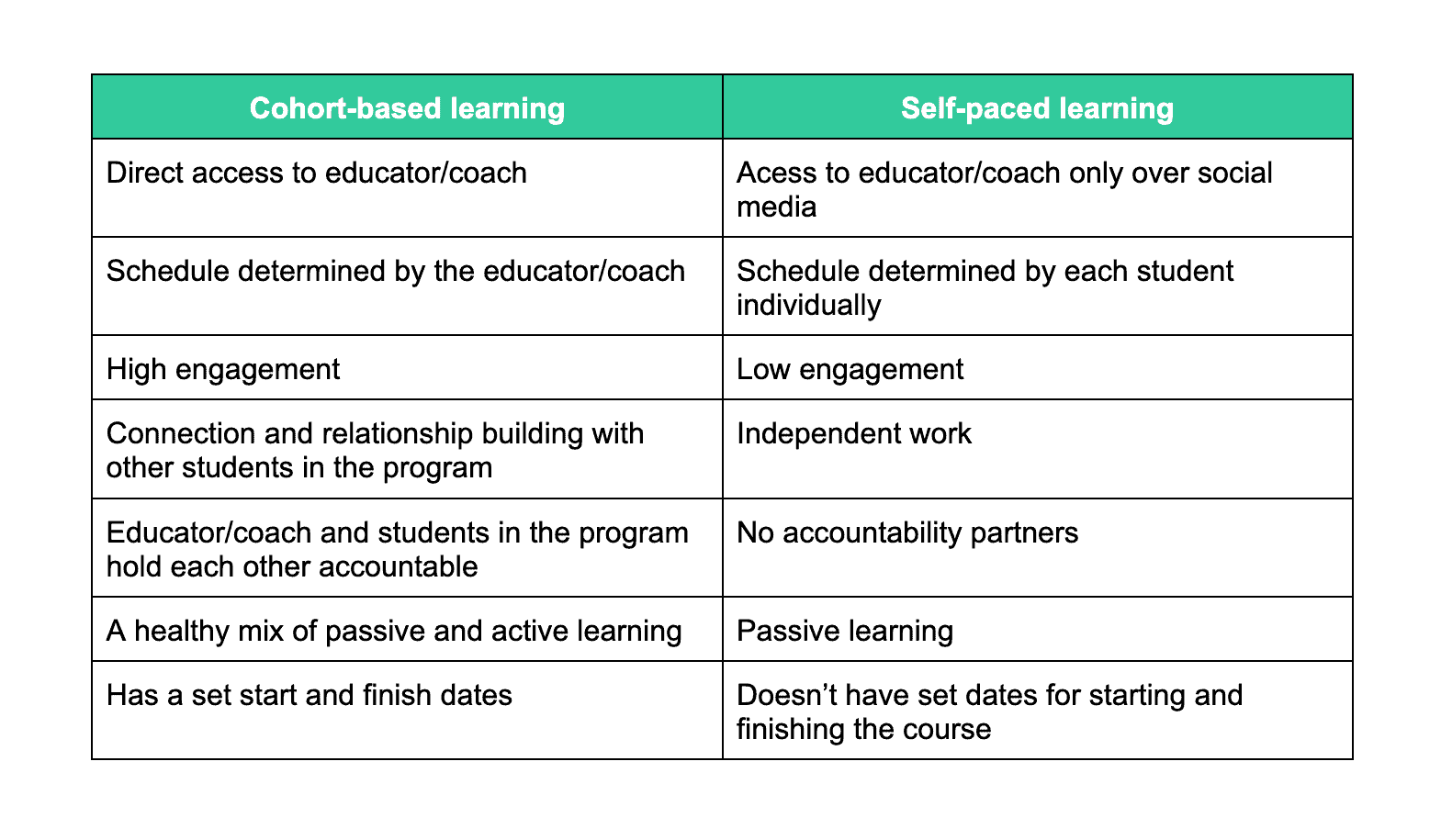Implement a cohort-based learning system with these 6 best practices


If you’ve been looking for a new, more engaging way to teach your students, then cohort-based learning might be perfect for you. It’s a learning concept that’s been gaining popularity in recent years due to its effectiveness in increasing online course completion rates. And the best news is that it’s effortless to implement even for new online course creators.
So, let’s take a look at what cohort-based learning is, why you should consider launching a cohort-based online course this year, and the best ways to do it.
What is cohort-based learning and the benefits of cohort learning?
Cohort-based learning is the type of learning where a group of students work through the curriculum of the course together at the same time. It’s very similar to the traditional education at universities and online education schools. But, the learning happens online and often in smaller groups to better the student experience.
Online course creators that implement cohort learning often have several course launches a year with a limited amount of students each time. This cohort based course offers a more intimate environment for learning while still allowing the students to choose when they want to take the course.
Accountability partner vs. room to breathe
There are, of course, some key differences between self-paced online courses and cohort-based courses. Self-paced learning gives way more breathing room and flexibility to students taking the course. Of course, some students might prefer this way of learning to complete a course.
However, online cohort-based learning provides something crucial to student success: access to the educator/coach and a community to hold them accountable. With these courses students all experience the course in real time with other students and their instructor.
Another key difference between the two learning models is the pacing of the curriculum. Students often get lifetime access to the course material with the self-paced course. That means they can take as long to finish the course as they want. Now, with cohort courses, students have a set amount of time to finish the course material and “graduate.” This difference can be significant when thinking about completion and student success rates.
To help you better understand how a cohort-based online course and a self-paced online course differ from each other, here are some of the other key differences:


Benefits for business
Launching a cohort-based online course can do wonderful things for your online course business. Here are key reasons why you should consider choosing this learning model over self-paced learning:
Better student success rates
The student success rate is a crucial metric to track for every online course creator. It can tell many things about your curriculum and whether it’s engaging and valuable enough for students to want to finish your online course. Research shows that with most MOOC (massive open online courses), the course completion rates are usually between 5 and 15%.
One of the ways to increase the student success rate for your online course is to increase its price. When students invest significant sums of money into an online course, they’re more inclined to go step by step and finish it. Harvard Business School reports that their online courses have a completion rate of 85%, and all that is due to their strategic pricing.
Another way to improve your student success rate is to offer a cohort-based learning program that will provide your students with the support and motivation to complete the course. A study conducted at the University of Toronto showed that students participating in cohort-based learning programs had better satisfaction with their learning experience. Students who are happier with their course are surely more inclined to finish it.
Word-of-mouth marketing
Testimonials and case studies showcasing your students’ successes are crucial for attracting new students and growing your online course business. With better student success rates, you’ll get more opportunities to create case studies that showcase how your online course helped your students achieve their goals.
Also, if more students complete your online course and have an amazing experience, they’re more likely to write a shining testimonial that will help you build credibility as an expert in the field.
Smarter scaling and pricing
The cohort-based course allows you to price your online course smarter and scale your profit better. In the teaching and coaching world, most self-paced online courses are low-priced items with high scalability. There is no limit to how many online courses you can sell. It’s just a matter of reaching a wider audience.
On the other side, there is the one-on-one coaching and masterminds where students pay premium pricing for an opportunity to learn from one educator/coach directly. This is a business model that’s profitable but hard to scale. There is so much time in a day you have for coaching, and eventually, you’ll reach the limit.
Cohort-based learning is a sweet spot between the two. You have the scalability of the self-paced courses and the premium pricing of one-one-one coaching. Because you’re going to be more involved with the students during the course duration, you can price your course at a higher price. And this also allows you to reach more students than you would with only one-on-one coaching, helping you change more peoples’ lives.
Building credibility
Building your personal brand as an online educator and expert in your field is crucial for running a successful long-term business. The more credibility you have, the more people will trust you, and more students will be willing to enroll in your courses rather than other online courses.
Cohort-based online courses can help you stand out and attract more students, helping you build your name as an expert. You will be guiding the students through their journeys and helping them achieve their goals which will build your credibility and allow you to grow your business faster in return.
6 best practices for starting your first cohort-based course
If you’re ready to start working on creating a cohort-based online course, then here are some of the key things you want to keep in mind:
1. Building your curriculum
Cohort-based learning curriculum will have to be different from any other curriculum you had in the past for your self-paced courses. First, you’ll want to find answers to these key questions to help you determine what to include in your program:
- Who is this course for?
- How can I help them solve a problem/achieve a goal?
- What parts of the curriculum should be self-paced and which should be done with a group?
- How does my role as an educator/teacher play into the lessons?
- What learning outcomes should students take away from each lesson?
When building your curriculum for a cohort-based course, you’ll want to find the golden middle between active and passive learning. Also, include some fun and interactive games where appropriate to help your students connect and have a break between learning new things.
Pay attention to pacing
With self-paced courses, you can provide as much information for your students as you want. You might give them 30 modules packed with information, and it works because they can take as much time as they need to go through them all.
Now, your cohort-based course will have a limited amount of time for your students to finish the course. So, you’ll have to make sure that you’re not overstuffing the curriculum with too much information. This will help you to go through the course lessons at a reasonable pace for your students to take away as much value as possible.
2. Chose the best format for cohort training
There are many different formats in which you can present the information to your students. With cohort-based learning, you’ll spend a large chunk of time doing video sessions with your students. You might consider recording those sessions and having them accessible for your students even after the lesson.
The way you present the information during the lesson can also vary. You can choose to pre-record videos and show them to your students, having a discussion after. Or, you can structure your lessons like webinars, showing slides presentations as you go through the material. You might also want to involve students and have them work together to learn the material while you’re there only to supervise the discussion and answer questions.
Tip: Get feedback from your students after each lesson to figure out which lesson format they find the most useful. This will allow you to make adjustments during the course to maximize your student success.
Now, when it comes to the passive learning part of your cohort course, you’ll want to find the best way to deliver your students the information. Some students are visual learners, while others prefer to read or listen to their material. The best thing you can do is to provide your course material in as many different formats as possible so that every student can find the best option for them.
You might also consider giving homework assignments that involve collaborating with other students in the course. Again, it will help your students connect with others, and learning together can help your students understand the course material better.
3. Keep a calendar of your cohort classes
Good organization is key for running a successful cohort-based course. Once you have your curriculum ready and know how you want to structure your course, you might want to create a calendar that your students can see with all important dates.
Include things like lesson times, Q&A sessions, 1:1 coaching (if you offer it), deadlines for homework, and everything else that comes with your course. Having a calendar to refer to will help your students plan their time, and they’ll be able to stay on top of their assignments and deadlines easier. Having a calendar to refer to will also help hold them accountable and ensure that they’re working on their goals.
4. Utilize tools to run things smoothly
You’ll want to take advantage of all the tools available to you for effortlessly running your cohort course:
Teachable will allow you to create landing sales pages to promote your course, handle the payments and house your course curriculum all in one place.
Zoom is by far the easiest and most comfortable platform for video calls. It’s free, easy to use, and available everywhere worldwide. You can share your screen, monitor who is speaking, and the app even allows you to record your sessions.
Discord is a great tool to use if you want to create a private community for your cohort students. It’s free to use and has an invitation-only feature that allows you to create a private server where you’ll be able to communicate with your students. You can also do audio and video calls and stream your content via Discord as well, so it’s great if you’re looking for a place to have everything in one.
Google Calendar can help you be organized and share all the events and deadlines with your student group. You can easily create a calendar specifically for your cohort group and share it with them to add it to their calendars. Google Calendar is free online and can be accessed by anyone with a basic Gmail account.
Facebook has a group feature that can be used for building your community. Create a group for your students to communicate with you and each other, where you can share information and even do Live sessions when needed.
You’ll need to ask for feedback from your students, and the best tool to help you do that is Google Forms. It’s easy to use, accessible to everyone, and can help you collect feedback from your students without hassle.
5. Set the pricing right
When it comes to the pricing of your cohort-based course, you’ll want to be smart about it. As we already discussed before, cohort-based learning is the golden middle between self-paced online courses and one-on-one coaching. So, the pricing also falls somewhere in the middle.
You’ll want to set the price of your cohort-based course higher than any of your self-paced courses. Because you’ll be investing time in it to teach and communicate with your students, you have to evaluate how much your time is worth and set the course price accordingly.
6. Build community
Your students are the most important part of your business. So, you’ll want to make sure that you invest your time and effort in building the community within your cohort-based course. Give your students a platform and space to connect.
Encourage the connections by including interactive teaching methods and assignments that require people to work with their fellow students. You might even want to go as far as assigning accountability partners to help your students go through the course curriculum easier.
For example: Let’s say you offer a cohort-based course on building meditation and mindfulness habits. Your curriculum might ask your students to spend 10 minutes each day meditating to build up their stamina and the habit of meditating. To help them achieve their goal, you might want to assign each student an accountability buddy so that each morning they would check in with each other after/before the 10-minute meditation.
This practice will surely help you cultivate a sense of teamwork and community while also improving the likelihood of students building new habits. Studies have shown that one partner changing behavior in a couple positively impacts the other partner’s habits.


FAQs
What’s a cohort-based course?
A cohort-based course is one where all of your students enroll, begin, take, and finish the course on the same schedule. This usually means hosting classes on a regular basis where all of your students will attend and go through each phase of the course together, as a cohort. This varies from self-paced courses that students can sign up for, begin, take and complete on their own time and schedule without other students taking it at the same time. Cohort-based courses can result in higher completion rates for students who feel accountable to take the course at a certain time. They don’t have to worry about choosing a time to do the course each week because it’s predetermined.
How do you create a cohort course?
You can create a cohort-based course the same way you would create any course. Think about your topic, how many weeks it would take to teach, and the number of students who could ideally be in the course at one time. You’ll plan out your course content the same way you would for a self-paced course. But you can include other aspects, like group work, or peer criticism and feedback sessions because you can be sure students will be taking part in class sessions at the same time, live, during the determined course time. Before launching your cohort-based course, run through it to be sure the content you plan to cover each lesson will fit within the allotted course time.

